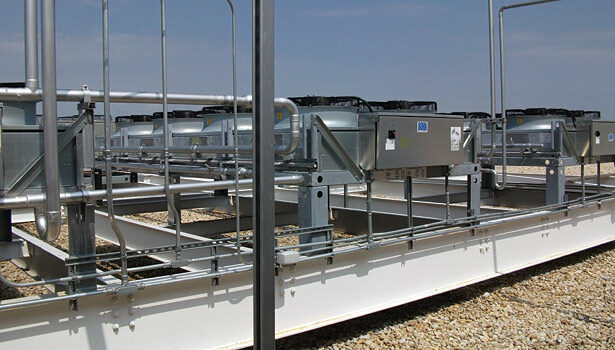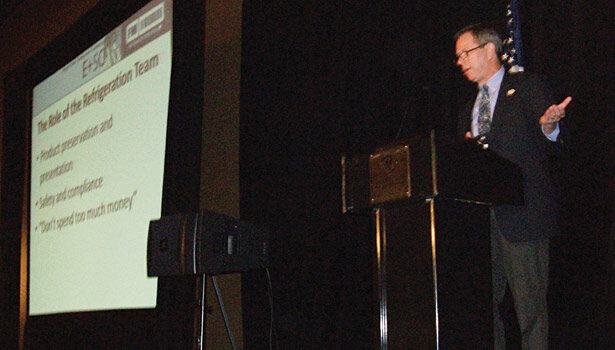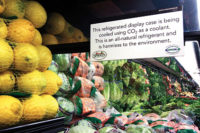More Refrigerants, More Ways to Use Them
Supermarket Sector Still Trying to Track Trends

Microchannel technology is employed in this rooftop system at a supermarket in Maryland.

Tom Land of the U.S. Environmental Protection Agency applauds the energy conservation efforts of the supermarkert industry.

Harrison Horning discusses use of a transcritical CO2 system in a supermarket at the Food Marketing Intstitute Energy and Store Development Conference.



No sector of HVACR has utilized more refrigerants over the past 25 years than supermarket refrigeration. It’s a sector still trying to get rid of an awful lot of hydrochlorofluorocarbon (HCFC)-22 in a whole lot of stores. Those decision makers taking the retrofit approach with R-22 systems are opting for hydrofluorocarbons (HFCs) with a R-407 series of refrigerants as an often talked about and used approach. But, for new installations, so-called natural refrigerants are Topic No. 1 as the sector wants to get an edge on any possible phase down in production of HFCs.
Here, based on presentations at the 2013 Food Marketing Institute Energy and Store Development Conference in Baltimore, are some of the most recent trends.
GreenChill Goes Natural
The U.S. Environmental Protection Agency’s (EPA) GreenChill Advanced Refrigeration Partnership has tossed down the natural gauntlet by giving a Best of the Best award to a Hannaford supermarket in Turner, Maine, for bringing the refrigeration system of the store online using just CO2 as the refrigerant in a transcritical approach. The award “goes to the best GreenChill-certified store of all stores certified in the past year,” according to the citation. The GreenChill awards recognize technologies that lower global warming potential (GWP) and refrigerant charge, both of which are possible with use of CO2.
Enter Transcritical CO2
Much talk these days involves the rationale and technical aspect of using transcritical CO2. For example, consider the perspective of Harrison Horning, director of equipment purchasing, maintenance and energy — North for Delhaize America, which owns the Hannaford supermarket chain. He noted the European-based parent company was sensitive to a statement from the Consumer Goods Forum that suggested phasing out HFC refrigerants as soon as 2015 and replace them with non-HFC refrigerant alternatives.
He said transcritical CO2 seems like the best option and that it is more economical in cold climates. He called the Maine store a pilot project and suggested it would remain that way until proven effective. He did say that while the store looks the same to customers, it looks different to technicians with one large rack for low and medium temp, three LT compressors, six MT compressors, a heat reclaim system, and a gas cooler with high-pressure expansion valve, pressure relief valve piping, and intercooler.
“It took a lot of time to learn and understand,” he said. “During the first three months of operations, the system seems to be working.” He did note concerns with fewer filters and, therefore, more plugged electronic expansion valves (EEVs) and heat exchangers not optimized yet in the pilot store. It is a continual learning process, he noted.
Expanding Refrigerant Options
Rajan Rajendran, vice president of engineering services and sustainability at Emerson Climate Technologies, addressed new directions for refrigerants. One aspect was lower GWP refrigerants and concerns continuing worldwide over global warming. These refrigerants include HFCs, hydrofluoroolefins (HFOs), and natural refrigerants, as well as developmental refrigerants still being worked on by refrigerant manufacturers.
His report detailed laboratory research being done by Emerson, which centered on research and the subsequent preliminary findings. Some of the current projects included comparing developmental refrigerants versus HFC-404A in reach-ins and walk-ins, as well as overall supermarket applications.
The work was part of the ongoing Low-GWP Alternative Refrigerants Evaluation program (LOW GWP AREP).
He noted the benefits of better maintenance of existing technologies, using currently available low-GWP alternatives to R-404A such as R-407A and R-407F, and looking at what he called revised system architecture encompassing such options as central rack, secondary, distributed, distributed self-contained, transcritical, and cascade CO2.
Moving Away from R-22
With all the reliance on R-22 that still is in supermarket refrigeration systems, a recurring theme is to look for HFC alternatives that closely match R-22 in both retrofit and new installations.
For example, a presentation at the FMI conference by Wayne Rosa, energy and maintenance manager for Delhaize America Shared Services, talked about retrofitting away in existing stores and the banking of R-22 by reclaiming it and shipping it to banking services.
And during a tour of a Weis supermarket during the conference, those viewing the site saw use of R-407A on the low side, the results of converting from R-22 to R-407C, and use of microchannel technology on the roof.
Publication date: 2/3/2014
Want more HVAC industry news and information? Join The NEWS on Facebook, Twitter, and LinkedIn today!








